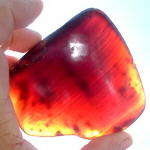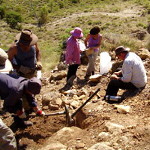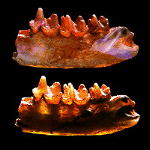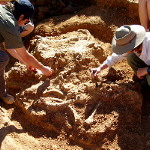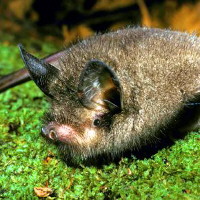 Mystacina. Photo credit: Rod Morris. |
Bizarre walking bat has ancient heritage: researchBy Bob Beale A bizarre New Zealand bat that is as much at home walking four-legged on the ground as winging through the air had an Australian ancestor 20 million years ago with the same rare ability, a new study has found. The discovery overturns a long-held held view that the agile walking and climbing skills of the lesser short-tailed bat - Mystacina tuberculata - evolved in the absence of any ground-dwelling mammal competitors or predators, says an international team of researchers led by Dr Suzanne Hand, a bat expert at the University of New South Wales, Sydney. Along with the American common vampire bat - Desmodus rotundus - the NZ bat is one of only two of 1,100 bat species worldwide that has a true four-legged walking gait when manoeuvring on the ground. It uses its wings as forelegs. Its thumb and toe claws have a unique extra talon for extra grip, plus a system of adhesive, gecko-like grooves in the soft, deeply wrinkled soles of its feet, The team has found that other special muscle and bone adaptations were also present in one of its extinct rainforest-dwelling Australian ancestors, fossils of which have been found at the rich Riversleigh World Heritage Fossil Site in north-west Queensland, it says in a report published in the journal BMC Evolutionary Biology. "The lesser short-tailed bat seems to be the sole survivor of an ancient Australian lineage now found only in New Zealand," says Dr Hand. "This study shows that, contrary to existing hypotheses, bats are not overwhelmingly absent from the ground because of competition from, or predation by, other mammals. "Unlike for birds, there is currently no evidence that any bat has evolved a reduced capacity for flight as a result of isolation on islands. "Rather, it would seem that walking is rare in bats because it has advantages for them only in special circumstances. Competition with other mammals and pressure from terrestrial predators does not deter modern vampire bats from walking. Likewise, the rich rainforest environment in which the ancestors of the mystacinid bats evolved in ancient Australia was teeming with ground-based competitors and predators." A small secretive creature with velvety fur, the lesser short-tailed bat is New Zealand's only terrestrial mammal: it spends long periods on the ground in heavily forested areas, hunting insects and seeking out fruit, nectar and pollen. It also appears to have evolved a special relationship as a pollinator for the Hades flower, or woodrose, a parasitic plant that produces nectar from blooms near ground level at the base of tree trunks. Among other unusual traits, the bat is thought to use its teeth and claws to excavate roosting burrows and males appear to compete for mates by gathering for singing competitions in their breeding season. Links:
Media contacts: Thanks to Rod Morris for the photograph. |
Latest news
|




